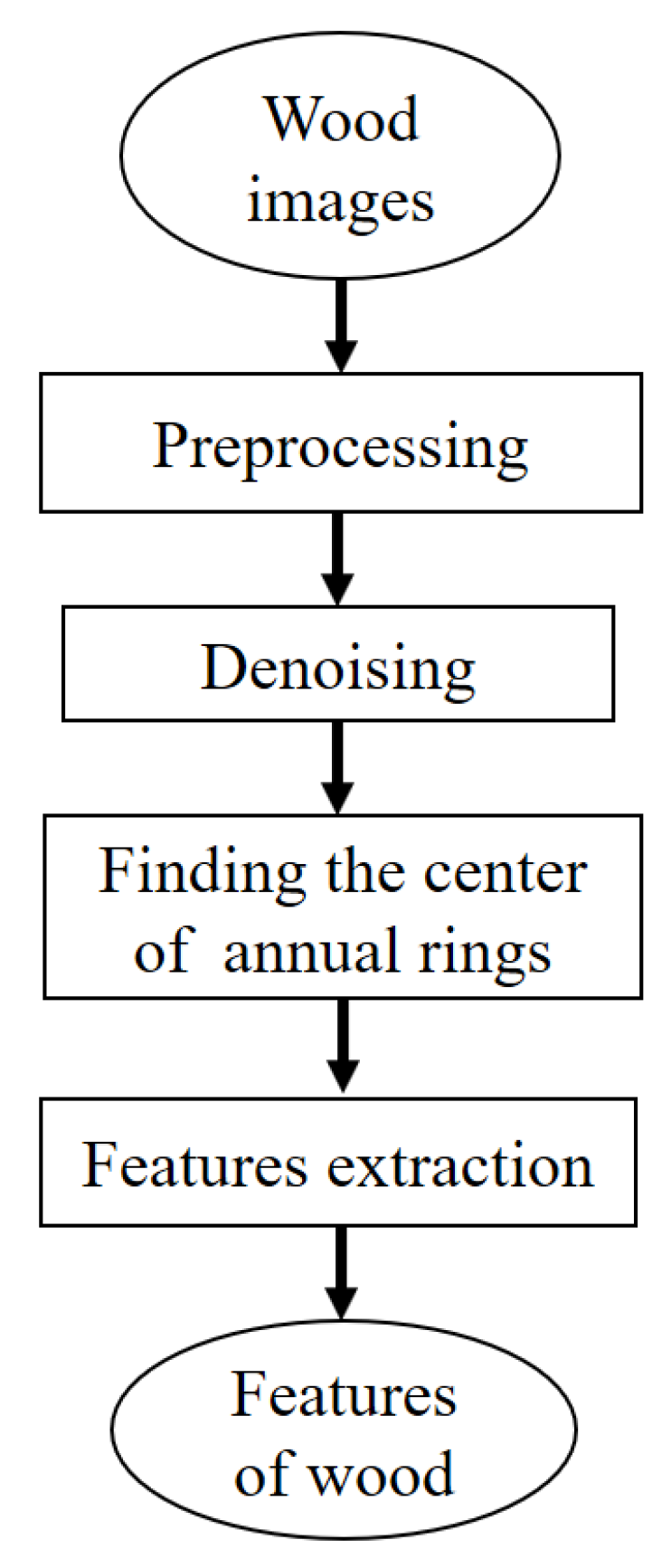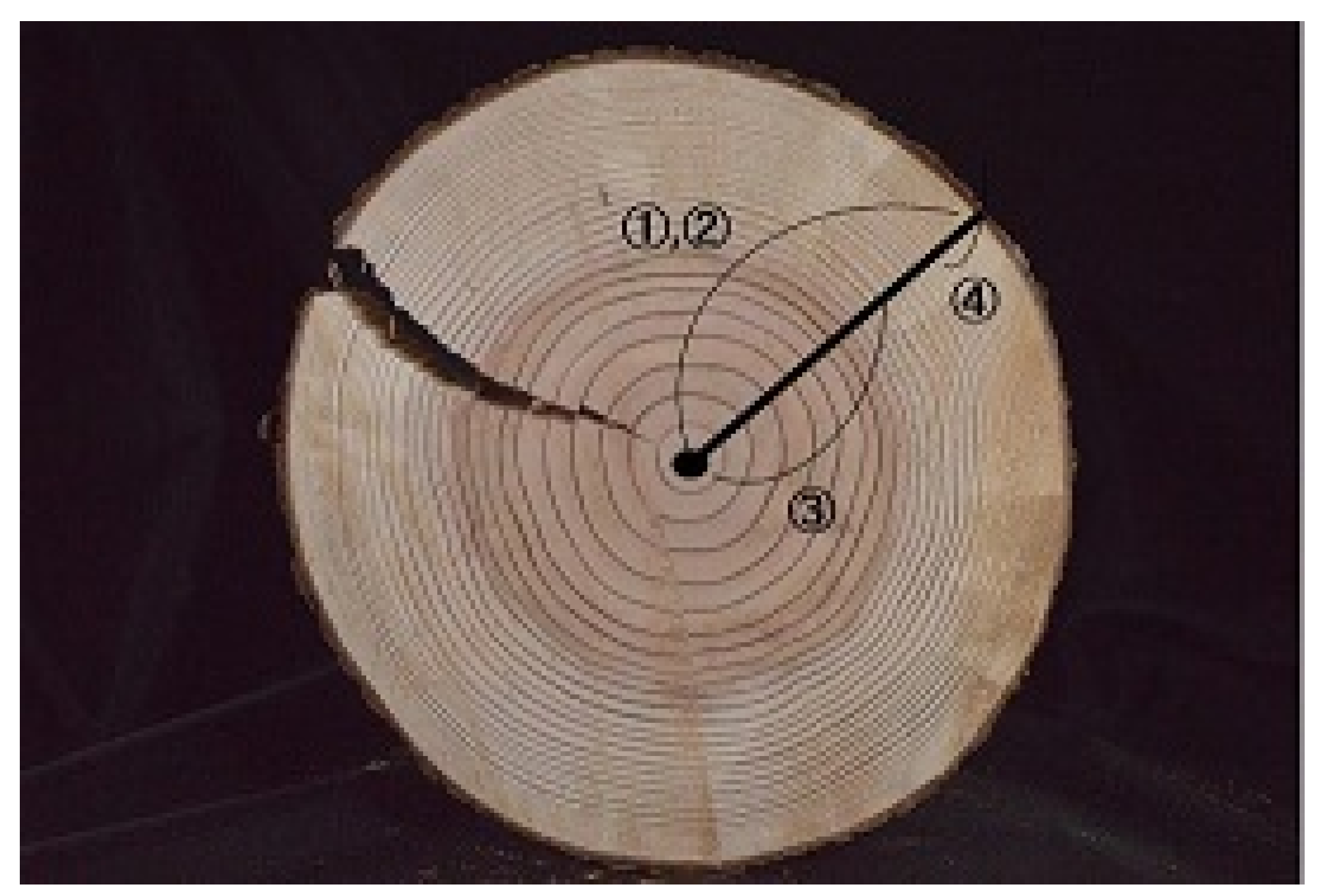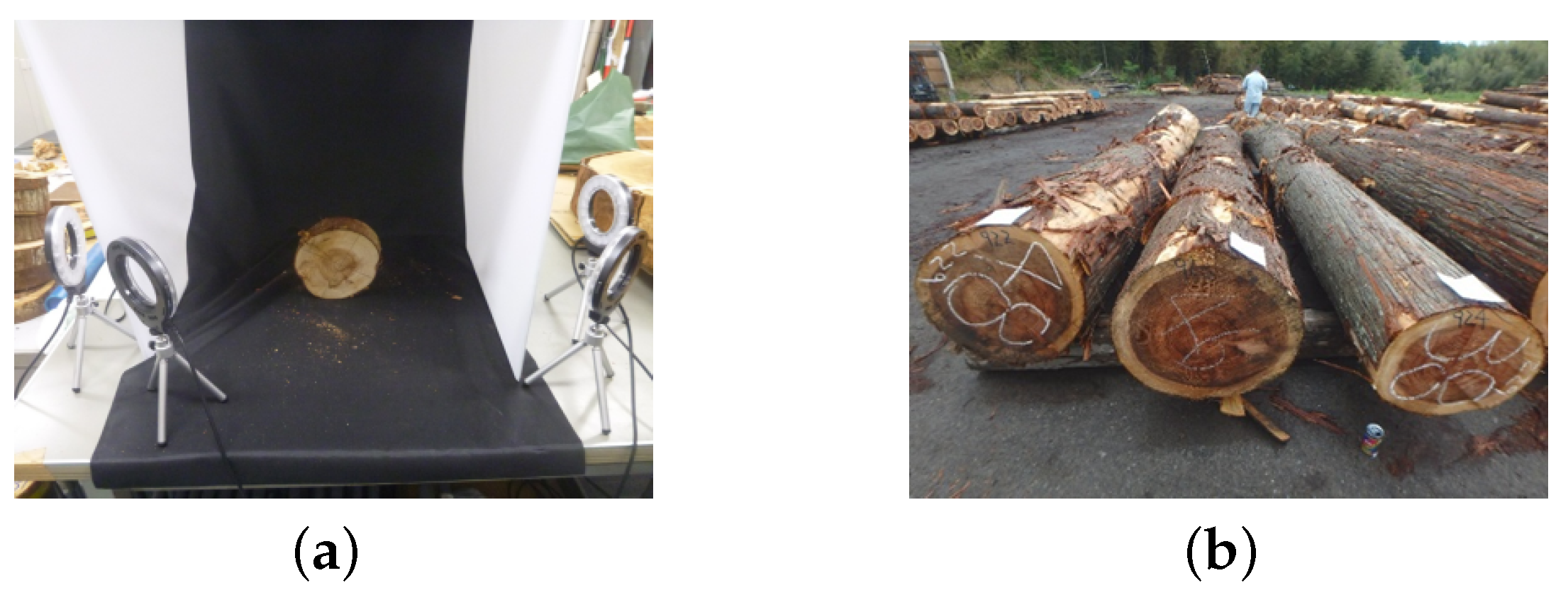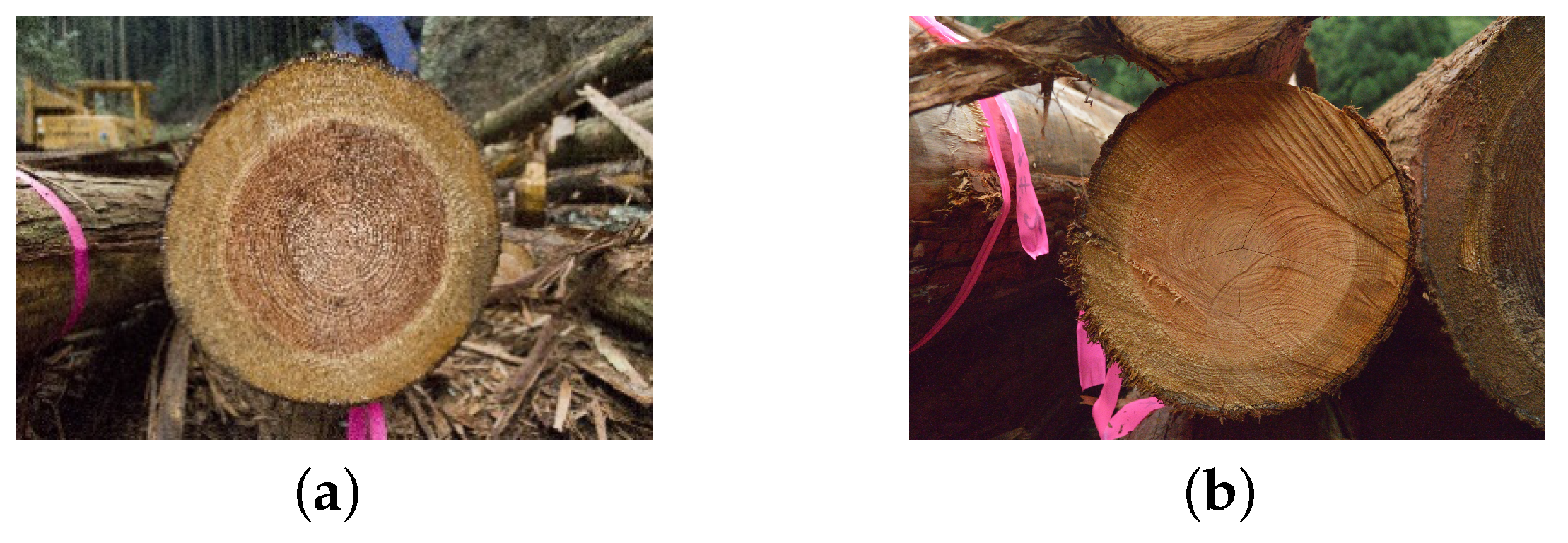Improved Hough Transform and Total Variation Algorithms for Features Extraction of Wood
Abstract
1. Introduction
2. The Process on Features Extraction of Wood
2.1. Preprocessing
2.2. Denoising
2.3. Finding the Center of the Annual Rings
2.4. Features Extraction
- The line equation can be generated with and as below to find intersection coordinates of each track and the wood image.
- A datum of the outermost edge in a wood image is taken at every 10 data to save time and ensure accuracy because the outermost edge of the wood image has a huge number of data. Therefore, to image edge coordinates, every ten coordinates are extracted. The extracted coordinates and wood center coordinates can generate an equation of the line and then find the intersection coordinates of each track and the wood image.
- The average number of these points at which the equations of each line intersect wood image is the number of the annual rings. The average width of an annual ring can be obtained through the distance from center point to the outermost edge divided by the number of annual rings. The other features can be obtained based on the intersection coordinates such as the average width of 15th ring from the center and outside from the wood image. The calculation of annual rings information is shown in Figure 4. ①, ② represent the number and average width of annual rings, and ③, ④ represent the average width of 15 rings from the center and outside.
3. Improved Hough Transform and Total Variation Algorithms
3.1. Improved Hough Transform
3.2. Total Variation Algorithms
4. Results
4.1. Time Comparison between the Ground Truth and the Proposal
4.2. Features of Indoor Wood Images
4.3. The Result of Outdoor Images
5. Discussion
6. Conclusions
Author Contributions
Funding
Institutional Review Board Statement
Informed Consent Statement
Data Availability Statement
Acknowledgments
Conflicts of Interest
Abbreviations
| TV | Total Variation |
| RMSE | Root Mean Squared Error |
References
- Forestry Agency of Japan. Annual Report on Forest and Forestry in Japan; Japan Forestry Association: Tokyo, Japen, 2018. [Google Scholar]
- Kishi, K.; Kojiro, K.; Akashi, H.; Adachi, W.; Fuchigami, Y.; Tabuchi, A.; Furuta, Y. Prediction of strength grades of lumbers by evaluating those of logs: Development of the simple and convenient prediction method as a case study of logs from areas in Kyoto prefecture. Wood Ind. 2019, 74, 140–145. [Google Scholar]
- Funck, J.W.; Zhong, Y.; Butler, D.A.; Brunner, C.C.; Forrer, J.B. Image segmentation algorithms applied to wood defect detection. Comput. Electron. Agric. 2003, 41, 157–179. [Google Scholar] [CrossRef]
- Mu, H.B. (Northeast Forestry University, Harbin, China). Personal communication, 2010.
- Gu, Y.H.; Andersson, H.; Vicen, R. Wood defect classification based on image analysis and support vector machines. Wood Sci. Technol. 2010, 44, 693–704. [Google Scholar] [CrossRef]
- Sioma, A. Assessment of wood surface defects based on 3D image analysis. Wood Res. 2015, 60, 339–350. [Google Scholar]
- Bai, X.B.; Guo, J.Q.; Chen, K.; Li, H.; Xu, J.T. Application study of GVF snake model in wood surface defects segmentation. J. Cent. Univ. For. Technol. 2015, 2, 90–95. [Google Scholar]
- Niu, L.; Sui, Z.z.; Zhang, C. Wood texture image processing based on FitzHugh-Nagumo reaction-diffusion equations. Nat. Sci. J. Harbin Norm. Univ. 2015, 31, 45–49. [Google Scholar]
- Fahrurozi, A.; Madenda, S.; Ernastuti, E.; Kerami, D. Wood texture features extraction by using GLCM combined with various edge detection methods. J. Phys. Conf. Ser. 2016, 725, 012005. [Google Scholar] [CrossRef]
- Xu, C. (Zhejiang Agricultur and Forestry University, Hangzhou, China). Personal communication, 2017.
- Xu, J. (Northeast Forestry University, Harbin, China). Personal communication, 2017.
- Zhang, Y. (Nanjing Forestry University, Nanjing, China). Personal communication, 2017.
- Chen, L.; Ge, Z.; Luo, R.; Liu, C.; Liu, X.; Zhou, Y. Identification of CT image defects in wood based on convolution neural network. Sci. Silvae Sin. 2018, 54, 127–133. [Google Scholar]
- Cheng, Y.; Li, Z.; Sun, Y. Detection algorithm of wood rings image baesd on texture feature. For. Eng. 2018, 34, 46–49. [Google Scholar]
- Ning, X.; Zhao, P. Segmentation algorithm of annual ring image based on U-Net convolution network. Chin. J. Ecol. 2019, 38, 1580–1588. [Google Scholar]
- Beck, A.; Teboulle, M. Fast gradient-based algorithms for constrained total variation image denoising and deblurring problems. IEEE Trans. Image Process. 2009, 18, 2419–2434. [Google Scholar] [CrossRef] [PubMed]
- Chan, T.; Marquina, A.; Mulet, P. High-order total variation-based image restoration. Siam J. Sci. Comput. 2001, 22, 503–516. [Google Scholar] [CrossRef]
- Ghofrani, S.; Markarian, H. Using high order total variation for denoising speckle, Gaussian, salt & pepper. Int. Conf. Micro-Electron. Telecommun. Eng. 2016, 282–286. [Google Scholar] [CrossRef]
- Rudin, L.I.; Osher, S.; Fatemi, E. Nonlinear total variation based noise removal algorithms. Phys. D Nonlinear Phenom. 1992, 60, 259–268. [Google Scholar] [CrossRef]
- Wu, W.; Zhang, Y.; Wang, Q.; Liu, F.; Chen, P.; Yu, H. Low-dose spectral CT reconstruction using ℓ0 image gradient and tensor dictionary. Math. Model. 2018, 63, 538–557. [Google Scholar] [CrossRef] [PubMed]









| (a) Features of the indoor wood image on a processed log (Figure 8a) | ||||
| pro. | NR | AR [cm] | AC15 [cm] | AO15 [cm] |
| GT | 33 | 0.3144 | 0.4842 | 0.1367 |
| Proposal | 33 | 0.3298 | 0.5130 | 0.1520 |
| PNTV | 42 | 0.2422 | 0.4080 | 0.1203 |
| (b) Features of the indoor wood image on an unprocessed low-noise log (Figure 8b) | ||||
| pro. | NR | AR [cm] | AC15 [cm] | AO15 [cm] |
| GT | 33 | 0.3298 | 0.5130 | 0.1520 |
| Proposal | 42 | 0.2422 | 0.4080 | 0.1203 |
| PNTV | 42 | 0.2422 | 0.4080 | 0.1203 |
| (c) Features of the indoor wood image on an unprocessed high-noise log (Figure 8c) | ||||
| pro. | NR | AR [cm] | AC15 [cm] | AO15 [cm] |
| GT | 35 | 0.2619 | 0.4078 | 0.1500 |
| Proposal | 34 | 0.2562 | 0.4634 | 0.1873 |
| PNTV | 51 | 0.1870 | 0.3901 | 0.1032 |
| Indoor | unpro.Low | unpro.High | |||
|---|---|---|---|---|---|
| N | 21 | 16 | |||
| AC15 | AO15 | AC15 | AO15 | ||
| Proposal | RMSE | 0.0350 | 0.0392 | 0.0627 | 0.0667 |
| Ratio | 8.04% | 9.83% | 16.08% | 45.83% | |
| PNTV | RMSE | 0.0493 | 0.0730 | 0.1315 | 0.847 |
| Ratio | 13.81% | 51.29% | 37.19% | 71.92% | |
| (a) Features of the outdoor wood image on the unprocessed low-noise log of Figure 9a | ||||
| pro. | NR | AR [cm] | AC15 [cm] | AO15 [cm] |
| GT | 56 | 0.2673 | 0.4330 | 0.1330 |
| Proposal | 54 | 0.2837 | 0.3987 | 0.1508 |
| PNTV | 75 | 0.1300 | 0.3510 | 0.1130 |
| (b) Features of the outdoor wood image on the unprocessed high-noise log of Figure 9b | ||||
| pro. | NR | AR [cm] | AC15 [cm] | AO15 [cm] |
| GT | 54 | 0.2370 | 0.4200 | 0.1870 |
| Proposal | 40 | 0.2747 | 0.3014 | 0.1082 |
| PNTV | 66 | 0.1180 | 0.3010 | 0.1063 |
| Outdoor | unpro.Low | unpro.High | |||
|---|---|---|---|---|---|
| N | 9 | 10 | |||
| AC15 | AO15 | AC15 | AO15 | ||
| Proposal | RMSE | 0.0515 | 0.0424 | 0.1368 | 0.0432 |
| Ratio | 15.95% | 22.28% | 44.46% | 20.25% | |
| PNTV | RMSE | 0.1230 | 0.0876 | 0.1763 | 0.0658 |
| Ratio | 28.37% | 59.02% | 55.62% | 75.23% | |
Publisher’s Note: MDPI stays neutral with regard to jurisdictional claims in published maps and institutional affiliations. |
© 2021 by the authors. Licensee MDPI, Basel, Switzerland. This article is an open access article distributed under the terms and conditions of the Creative Commons Attribution (CC BY) license (https://creativecommons.org/licenses/by/4.0/).
Share and Cite
Du, W.; Xi, Y.; Harada, K.; Zhang, Y.; Nagashima, K.; Qiao, Z. Improved Hough Transform and Total Variation Algorithms for Features Extraction of Wood. Forests 2021, 12, 466. https://doi.org/10.3390/f12040466
Du W, Xi Y, Harada K, Zhang Y, Nagashima K, Qiao Z. Improved Hough Transform and Total Variation Algorithms for Features Extraction of Wood. Forests. 2021; 12(4):466. https://doi.org/10.3390/f12040466
Chicago/Turabian StyleDu, Weiwei, Yarui Xi, Kiichi Harada, Yumei Zhang, Keiko Nagashima, and Zhiwei Qiao. 2021. "Improved Hough Transform and Total Variation Algorithms for Features Extraction of Wood" Forests 12, no. 4: 466. https://doi.org/10.3390/f12040466
APA StyleDu, W., Xi, Y., Harada, K., Zhang, Y., Nagashima, K., & Qiao, Z. (2021). Improved Hough Transform and Total Variation Algorithms for Features Extraction of Wood. Forests, 12(4), 466. https://doi.org/10.3390/f12040466






